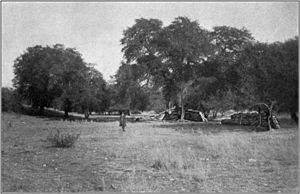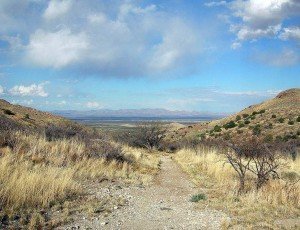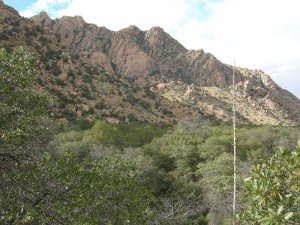Fort Apache located in the foothills of the White Mountains of Arizona offers a very interesting travel stop. The fort was established in 1870 at the confluence of the east and north forks of the White River. This was a very important military outpost in the center of the White Mountain Apache homeland and today is within an Apache Arizona Indian Reservation.
One of the most interesting aspect of Fort Apache is what was established there in the latter years of the fort’s existence. This was the Theodore Roosevelt School, established in 1923 by an act of Congress.

There were many ways to start an Indian war in 1800’s America. One way was to take land from the Native Americans and force them to live on reservations. Another way was to hunt the buffalo to near extinction thus taking away the most important source of their sustenance. Still another was to make a treaty and then break it. In the 1861 Arizona Territory a new way was found. That was to kidnap a chiefs family and hold it for ransom.
The Story Begins
This story starts in 1861 when a Tonto Apache Indian party raided a ranch in far southern Arizona Territory. The raiders stole livestock and ended up kidnapping a twelve year old boy, a stepson of the rancher’s Mexican wife. The rancher told his story to the local military at nearby Fort Buchanan (the remains of which are pictured below right). The commander, a Colonel Morrison, ordered a Lieutenant George Bascom to take a large contingent of troops and locate the boy. It’s thought that while the army (Morrison) wanted to make a concerted effort to find the boy and have the ranchers livestock returned, his main concerns were the raging Civil War back east. He may not have been involved as much as he should have been in the unfolding drama.

Lieutenant Bascom
A bit also needs to be said regarding Bascom’s background and experience. A Kentuckian and recent graduate from West Point, he had just recently arrived in the Arizona Territory about three months prior. He was unfamiliar with the area and likewise unfamiliar with the Apaches. In other words, he was inexperienced on the ground. Likewise, the troopers assigned to accompany him were a new contingent of troops also inexperienced. Not a good combination to deal with a delicate kidnapping situation as future actions would reveal.
The Story Unfolds
Bascom was unable to locate the tribe or the boy. Bascom’s opinion however was that the raid and kidnapping was done by the Chiricahua Apaches which is what the rancher claimed.
His commander then ordered him to go after the Chiricahua’s and do anything necessary to free the boy. That’s a fairly open order and a lot of responsibility for a relatively new Lieutenant.

Bascom along with 54 troopers traveled to a location known as Apache Pass where a Butterfield Stage station was located. In fact, the two station attendants were familiar with Cochise who had a winter camp in the nearby rugged mountains.
There Bascom sent word that he wanted to have a meeting with Cochise. Bascom and his men set up tents about a mile away from the stage station and awaited Cochise. Apparently Cochise, who had a reputation for honesty, was suspicious of the meeting and as a precaution took along several family members.
What happened next was probably not a good move by the army. When Cochise and his family arrived at the meeting site pictured to the left, Bascom arrested him. Cochise managed to escape from the troopers and in retaliation Bascom took captive five members of Cochise’s family. This appeared to be the tipping point.
The Conflict with Cochise Grows
A short time later Cochise sent a message to Bascom pleading for the release of his family members. Lt. Bascom refused the request and simply sent word back to Cochise that his family would be released when he twelve year old boy was released. When Cochise received Bascom’s reply, he went out with some braves and attacked and kidnapped three Americans. Cochise planned to trade the Americans for the release of his family. Bascom refused to negotiate with Cochise. Cochise was in a corner.

The situation just continued to escalate. Cochise, pictured to the right, decided to flee to nearby Sonora Mexico and on the way he killed the three American captives. Not a wise thing to do. This intensified the conflict.
A short time later Cochise sent a message to Bascom pleading for the release of his family members. Lt. Bascom refused the request and simply sent word back to Cochise that his family would be released when he twelve year old boy was released. When Cochise received Bascom’s reply, he went out with some braves and attacked and kidnapped three Americans. Cochise planned to trade the Americans for the release of his family. Bascom refused to negotiate with Cochise. Cochise was in a corner.
The situation just continued to escalate. Cochise, pictured to the right, decided to flee to nearby Sonora Mexico and on the way he killed the three American captives. Not a wise thing to do. This intensified the conflict.

When Bascom came upon the remains of the murdered Americans he hung all five of Cochise’s family members in retaliation. It’s not entirely clear who exactly made that decision.
The moment Cochise learned of the killing of his family is commonly recognized as the start of the 25 year long Apache War. An interesting fact is that the Apaches from Arizona looked upon the Mexicans as there enemies, not the Americans. The antagonism toward the Mexicans was an offshoot of the years of Spanish rule. It was the Spaniards who originally explored the American southwest and it was the Spaniards who first changed the Apache way of life. This was the situation in the entire southwest, all the way from Texas to California.
See the Trips Into History articles on the links below…
The Sioux War and the Army’s First Victory After Custer’s Defeat
A Visit to Fort Apache Historic Park
Could Be The best Hiking Trail in Sedona Arizona
A Situation Out of Control
The act of the kidnappings and the escalation that followed went out of control. The killings of the kidnapped victims turned into a catastrophe that in all respects could have been avoided. When you consider what occurred, you almost have to ask if the higher authorities were involved or was the kidnapping of Cochise’s family by Lt. Bascom a decision made by him alone. If it was a spur of the moment decision by an inexperienced young officer then the 25 year long Apache War may have been avoided.
It should also be noted that the period from 1862 to 1886 when Geronimo (pictured left) finally surrendered was not the only period of conflict with the Apaches.
Skirmishes took place as far back as the 1840’s and even after Geronimo’s surrender there were small skirmishes up to about 1900. Most of the latter skirmishes resulted from the army trying to put wayward Apaches back on their reservation land.
Small fights also resulted between Apaches and miners and ranchers over suspected theft of livestock and property.
The question really is would there have been conflicts with the Apaches regardless of the Bascom Affair? With settlers heading into the territory in large numbers there certainly would have been problems. Would the warfare go on as long as it did without the Bascom Affair? You be the judge. Nobody knows for certain.
Visit Fort Apache
For those wishing to visit Fort Apache Historic Park, the site is located on the Fort Apache Indian Reservation about a 170 mile drive east/northeast of Phoenix Arizona, about a 190 mile drive north of Tucson and a 29 mile drive south of Pinetop-Lakeside Arizona.
(Article copyright Trips Into History. Photos of Fort Apache from Trips Into History collection. Remaining photos and images in the public domain)

